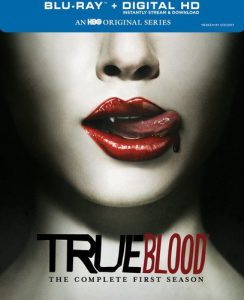I’ve watched most of the first season on DVD, and I can safely say I’m a fan of “True Blood.” Being a huge “Buffy/ Angel” fan, I have trouble liking other vampire stories because I compare them to Joss Whedon’s work.But I like Alan Ball’s “True Blood” because it’s its own thing — the iconic vampire show of the late-Oughts is quite different from the iconic vampire franchise of the late-’90s.
Here are 10 differences in the two vampire lores.
1. What happens when a vampire is staked.
On “Buffy,” it explodes into dust, leaving a small pile of ash. In a late-series episode, Buffy stakes three vamps in quick succession with broken-off shovel handle like she’s playing an arcade game.
On “True Blood,” it explodes in an orgy of blood and melted organs, creating an incredible mess. My friend Seth recommended “True Blood” to me. I asked what happens when a vampire is staked, and he said, “Oh, it just turns into a pool of blood.” Not so bad, I thought.
But when Bill stakes the bartender vamp who is attacking Sookie, it pukes up blood for like a minute before melting, leaving Sookie drenched in red goo that she can’t quite clean off for the remainder of the episode. It’s utterly disgusting. But also, I have to admit, not as frivolous as when Buffy mows through vamps like it’s a light workout.
2. The goodness or evilness of vampires.
On “Buffy,” vampires are a human shell inhabited by an evil, soulless demon (although the human personality and human memories are retained). The vampire is not the human, and yet it is (don’t think too hard about it).
On “True Blood,” it’s the same person (as good or as evil as when they were human), only now the being is immortal and subsists by drinking human blood.
3. What vampires need to survive.
In both cases, vampires prefer the taste of human blood. But in neither case do they absolutely need human blood. On “Buffy,” Angel survives (although he doesn’t thrive) on rat’s blood for a century after regaining his soul. On “True Blood,” vampires can drink TruBlood, a synthetic blood sold in six-packs like beer.
On “Buffy,” animal blood works, but on “True Blood,” it seems that only human blood will do. However, on “Buffy,” vampires almost always completely drain a victim, even for a light snack. On “True Blood,” vampires can feed on a human without killing or even seriously hurting them (when Bill sucks on Sookie, she replenishes herself afterward by eating vitamins).
“True Blood’s” definition of “feeding” is important, for it allows Bill to truly be defined as a good vampire. Yes, he had to feed on humans to survive before TruBlood was invented. But since he didn’t have to drain humans, he can be seen as unambiguously good rather than as a reformed murderer. The first time he turns a human into a vampire — Jessica, near the end of Season 1 — he does so only because he’s forced into it by a vampire court.

4. The personalities and lifestyles of vampires.
In both cases, the vamps have the same personalities as when they were human. On “Buffy,” selected vampires (Angel, Spike, Darla, Drusilla, Mr. Trick, etc.) have strong personalities, but the ones Buffy stakes on routine patrols are just faceless drones. On “Buffy,” the previously repressed personality comes out in vamp form; for example, the vamp version of Willow is blatantly gay.
“True Blood” likes its vamps — and all its characters — to have distinct personalities. And they aren’t necessarily evil (whereas all “Buffy” vamps are evil, unless they are re-souled). A notable example is Eddie, a lonely guy who watches a lot of TV and exchanges his blood (“V” is a valuable drug) to Lafayette for sexual favors.
On both shows, vampires favor old dwellings that were abandoned by humans (Angel finds a mansion, Spike and Dru settle for a warehouse, Bill lives in his family’s old place). Or sometimes they just rent or buy like the rest of us. On “Buffy/Angel” vampires sleep in beds (with the drapes drawn, of course); on “True Blood,” they sleep in coffins or coffin-like enclosures (Bill sleeps under the floorboards).
5. Vampires’ place in society.
“Buffy” had the vamp hangout Willy’s Tavern, and “Angel” had the demon karaoke bar Caritas. At first, it was explained that the populace pretended not to see what it didn’t want to see. By the later seasons of “Buffy” (when Sunnydale is blown up) and “Angel” (when Los Angeles is sucked into a hell dimension), such willful ignorance is no longer possible. Humans acknowledge the existence of demons and vamps, although they treat them with extreme suspicion.
“True Blood” has the vampire bar Fangtasia (humans hang out there in order to live on the edge). Everyone thought vampires were a myth until TruBlood brought them out of the shadows, but now they can’t be ignored. There is definite “racial” tension between humans and vamps; that’s the central theme of the series. Some critics have made the comparison to gays’ position in modern society, in that vampires almost have equal rights, but in some cases they don’t, and there is a lot of bigotry against them.
6. The physiology of vampires.
On “Buffy,” they don’t breathe, but they can draw air through their lungs to mimic breathing (thus, they can smoke cigarettes). They don’t have to eat, but they can go through the motions in order to fit in. Overall, vampire physiology very loosely explained.
On “True Blood,” vampires run on blood the same way cars run on gas. Vampire blood itself, though, is different from human blood. Called “V” by drug dealers, one drop ingested by a human can result in an incredible high.
7. Whether they see their reflection or not, and other aspects of the mythology.
On “Buffy,” vampires don’t cast a reflection in a mirror. On “True Blood” they do (the mirror thing is a myth that vampires perpetrated, Bill tells Sookie). Crosses and holy water burn “Buffy” vamps; crosses are just two pieces of wood on “True Blood,” and as far as I know, holy water doesn’t bother vamps, either.
This makes sense: “Buffy” taps into the fantasy genre for its vampire rulebook, but “True Blood” wants to be rooted in reality. The latter show basically says, “What if vampires actually were real? What aspects of the mythology would make sense, and what aspects would be inexplicable?” It keeps only the aspects that could be explained using logic (even if it’s a stretch).
8. Vampires’ special abilities and weaknesses.
Bill gets past a traffic cop the same way Obi-Wan gets past the stormtrooper patrol in “Star Wars.” “True Blood’s” glamouring basically rips off the concept of the Jedi mind trick. On “Buffy,” Drusilla is able to freeze Kendra before killing her, and Dracula turns Xander into his slave. In both franchises, vamps can develop this mesmerizing skill, but not all vamps have mastered it.
Other traits shared by both mythologies: Vamps are super-strong (but can be weakened if low on blood), really fast, incredibly stealthy and quick to heal. On “True Blood,” the speed is shown using a cool special effect like how Teek moves in “Ewoks: The Battle for Endor.” The old cliché of the vamp sneaking up on a human without a sound is used in both franchises (Sookie hates it when Bill does that, just as Buffy hates it when Angel does that).
The most famous vampire weakness is shared by “Buffy” and “True Blood”: When they are exposed to sunlight, they burn up. On “True Blood,” though, they burn up faster than on “Buffy.” In fact, Angel is able to stand in indirect sunlight with no ill effects.
On “True Blood,” vamps are weakened by silver (it’s like an extreme allergy). That’s not the case on “Buffy.”
9. How humans are turned into vampires.
On “Buffy,” the human drinks the vampire’s blood before dying, then wakes up after awhile as a vampire. I think the “True Blood” mythology is the same, although this is not explained clearly, at least in the episodes I’ve seen.
On “Buffy,” the vampire who does the “turning” is called a “sire.” On “True Blood,” they are called a “maker.”
10. Vampires’ aging and maturing.
Both Angel and Bill are something like 150 years old, and both go for much younger women (Buffy is 15 at the start of the show, while Sookie is about college age). Granted, Angel looks 25 and Bill looks 35, so it’s not too much of a stretch in that sense. But, remember, they are literally more than a century older than the object of their affection. Maybe the theory that women mature faster than men (and the related theory that women like older men) really is true– the central romances on these shows suggest as much.
Anyway, there’s a primer for you “Buffy/Angel” fans wondering if you should give “True Blood” a taste. It’s not better, but it’s good in its own way. They are very different shows, and yet I think “Buffy/Angel” fans will want to try this new vampire series.
After I finish watching Season 1, I’ll share details on what I like about “True Blood.”

